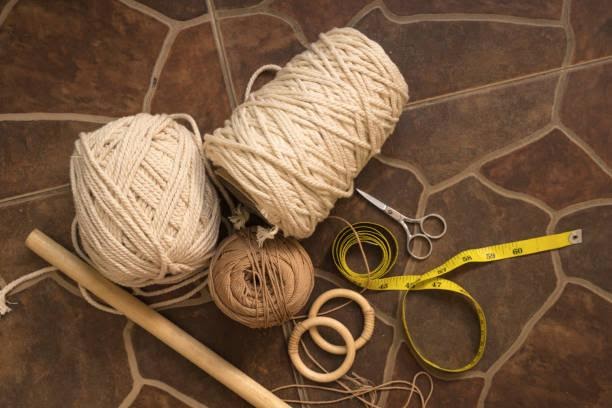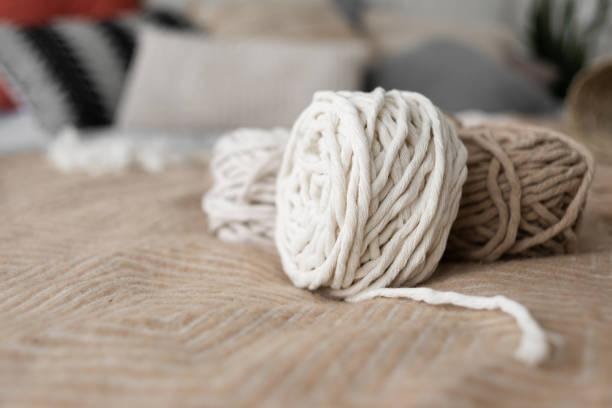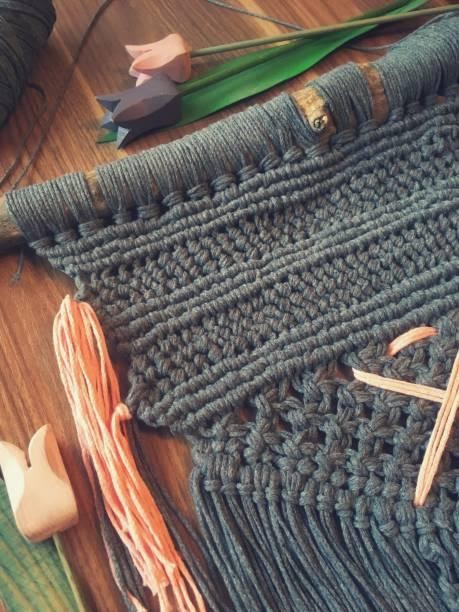Best Macrame Cords and How to Measure their Length for a Project?
Everything about Macrame Cords and How to Measure their length for your next project.

Macrame is a fascinating art to make a variety of projects, including fashion accessories, ornamental arts, and even large home decor items. It’s incredible how just twisting and knotting strands of cord together can result in a variety of beautiful home decor. Macrame cords come in a variety of designs, and widths. It might be frightening for beginners who are just getting started with macrame to choose the right cord for their project.
It’s important to consider the pattern first when measuring the cord for a macrame project. For example, you will probably need an additional cord if your pattern includes a lot of knots . You can cut the cord a little shorter if your pattern has a lot of straight cords.

What is the best cord for Macrame?
Choosing the right cord is an important step when starting a macrame project. There are so many options available. This can be a fun and exciting process, but it can also be frustrating if you don’t know where to start.
The ideal macrame cord varies with each project, but it should be braided or twisted and composed of strong and durable material. Although each project takes a different variety of macrame cable, considering how the macrame cord users choose will affect the completed product’s aesthetic, texture, durability, and stiffness.
Whether you’re looking for rope, cord, thread, or yarn, you’ll have to choose between natural and synthetic materials. Cotton, linen, jute, wool, and hemp are examples of natural fibers that may be used for indoor macrame projects, home décor, jewelry, accessories, and gift wrap. They’re also biodegradable.
The most important factor is the macrame cord material. It has an impact on your project’s overall appearance, strength, and lifespan. Cotton is the most typical macrame material, which is affordable and beginner-friendly. Cotton cords are ideal for jewelry, wall art, and other fashion items. A macrame cord’s strength is primarily determined by the materials used to make it. Jute, leather, ribbon, and nylon string are all strong materials.

1. Braided cords
You can see that cords are made up of smaller strands that are twisted or braided together. The strands of braided cords are less likely to unfold and are more structurally sound. They are stronger and thicker than twisted cords, but they are also more expensive. The braided cord gives the finished project greater depth and rigidity, which is more difficult to create with a twisted cord. Making plant hangers, tapestries, or carpets would be the finest option. It can be waxed or left natural, with a waxed cord having a heavier weight and making knots easier to tie.
2. Twisted cords
Twisted cords are more commonly used in macrame projects because they help you make the typical macrame aesthetic, but the strands are more likely to split. If the macrame design involves fringes at the end, twisting cords is used instead of braided cords because braided cords are much more difficult to comb out. If you’re working with a twisted cord, putting the ends in clear wax will help keep it from fraying. Twisted cords are thin enough to make intricate macrame designs while still being strong enough to carry weight, which is ideal for plant holders and hanging shelves.

3. Thick and Stiff Cords
You should pick the proper cord thickness and stiffness based on the pattern. Cords that are 6-8 mm thick and relatively stiff can assist large-scale projects such as table runners or wall hangers to take their appropriate shape. Smaller and leaner cords, such as 2 mm, will produce the finest results for smaller projects like earrings and necklaces. Macrame cord thickness is typically measured in millimeters.
If you’re including beads or hooks in the design, remember that the string must be able to pass between them. A cable should be able to bend and curve in keeping with the pattern’s specifications. If you are making a bracelet or choker, a thinner macrame string is perfect. Cotton embroidery cord is extremely soft and flexible. You may also use leather, but it should be no wider than 2 mm.
4. Smoother cords
The texture of your cord can enhance the entire appearance of your project, and it’s especially essential if you’re making items that will come into contact with your skin frequently, such as chairs or fashion accessories. The texture of your macrame cord is determined by the material it is made of, as cotton or synthetic materials are smoother and nicer on the skin, making them ideal for accessories.
5. Single Stranded Cords

If you’ve attempted a few projects with cheaper cords and now want to upgrade to a higher-quality cord for higher-quality projects, a single strand cord could be suitable for you. You should use an ideal cord if you are a newbie. You should consider a single-stranded cord for your macrame project since it will make it more enjoyable.
If your design requires fringe, a single twisted cotton rope unravels quickly with a broad comb. The single twist pattern also lends a delicate, bohemian vibe to the finished result, making it ideal for decorative projects. Cutting cords and fringing will no longer be a problem, and your macrame creations will look much better as a result.
Best Cord Size for Macrame
The cord size depends on what you’re making. For example, Plant hangers require about 20m of a macrame cord. You’ll need more cord for wall hangings than for plant hangers. This varies greatly depending on size and design factors.
Size is determined by the project we are going to start. For example, thicker designs need thick macrame cords, while delicate designs need thinner cords.
Best cord for Tassels

Tassels are a perfect complement to many macrame projects. It adds a fun aspect to your work. When it comes to choosing the best cord for tassels, you have a lot of options. Each sort of cord has its own set of characteristics, and you aren’t restricted to a single material. The best cord for tassels is silk. When it comes to creating tassels, a wool-silk combination is a great choice. It depends on the tactile experience you desire from your tassels, as well as whether you want something high-end or something inexpensive and long-lasting.
Best cord for wall hangings

You should use 100% cotton rope for Macramé wall hangings and plant hangers. It’s soft on your hands, knots quickly, and can be dyed if you have some spare time. Thick Twist cords are best for the macrame wall hangers and plant holders. It can be stretched as you use it and you’ll be able to achieve a dense luxurious tight tapestry look. You can also use three Strand if you are working on a more structured pattern as it holds its shape slightly more than Thick Twist.
Best cord for Hammock

When determining if a rope is strong enough to support a hammock, there is a formula to follow. Divide the rope’s diameter by three and m Multiply by 2,000 to get the weight that a rope can support. The safe working weight of a 1-inch rope is 2,000 pounds, which is more than enough to hold any hammock. The cord you choose for the hammock must be flexible enough to loop around it. When you’re looking for a cord for your hammock, remember that you don’t need the largest cord in the shop. All you need is a thick, flexible, and good-quality strong cord.
Best Cord for Macrame Feathers

A single-strand cotton cord is ideal for macrame feathers. Make sure you have the proper stuff because it’ll work best for brushing out the fringe. You can make lovely macrame feathers that can be used as a keychain, a purse tassel, or turn them into a beautiful wall hanging. You can get it in a variety of colors, so feel free to try with different combinations. You can also use a wool cord for your macrame feathers.
How to Choose the Best Macrame Rope
For projects which require extremely durable materials, like with a large plant holder, select cords made of thicker materials, since they will allow the thin macrame to last longer and provide more support for heavier items. The cord’s pricing is also influenced by its materials. Hemp, jute, and silk are generally more costly than cotton or cotton blends. If you’re making a heavy-duty project, choose a durable material.

1. Jute Macrame rope
Jute is the best alternative for a variety of Macrame designs. It’s not too expensive, and the cord’s thickness ensures quick results. When jute is used in a project, it will be exposed to electric or natural light for a long time.
2. Nylon Macrame rope
A nylon cord is best for different macrame designs with beads. When selecting a nylon cord, start by looking for the biggest diameter thread that will fit in your smallest bead hole. A nylon cord helps in keeping the beads firmly attached to the rope and prevents them from moving. Nylon Cord comes with a pre-threaded needle to make bead stringing easier. Nylon is a long-lasting material that is less prone to fray when exposed to sharp bead edges.
3. Hemp Macrame rope
Hemp cord is commonly used in macrame arts and crafts. You can make macrame jewelry out of hemp co as it is gentler on the skin and is renowned to be silky, robust, and durable. If you plan on wearing it as a bracelet or necklace, you will notice that it is much softer on the skin, and it also makes unknotting much easier if you manage to make a mistake.
Calculate Macrame cord lengths by using Calculator
The size of cord you choose depends on the design you’re going to make. You’ll want to know about all of the different cord sizes available while making your macrame project. To measure a macrame cord for a project, you should know the kind of design you’re planning to make and how tight or loose your knot design is.
| Desired | 1mm | 2mm | 3mm | 4mm | 5mm | 6mm | 7mm | 8mm | |
| Cord | 1mm | – | -50% | -66% | -75% | -80% | -83% | -90% | 84% |
| Length | 2mm | x2 | – | -33% | -50% | -60% | -66% | -75% | -72% |
| 3mm | x3 | x1.5 | – | -25% | -40% | -50% | -60% | -60% | |
| 4mm | x4 | x2 | up 33% | – | -20% | -33% | -45% | -48% | |
| 5mm | x5 | x2.5 | up 66% | up 25% | – | -17% | -30% | -36% | |
| 6mm | x6 | x3 | x2 | x1.5 | 20% | – | -15% | -24% | |
| 7mm | x7 | x3.5 | x2.5 | x1.8 | 40% | 17% | – | -12% | |
| 8mm | x8 | x4 | x2.7 | x2.2 | 60% | 33% | up 15% | – |
The most basic equation for calculating the length of the ropes is multiplication by the same number of the macrame length, followed by multiplication by two. If you want to produce a 2mm macrame with a braided cotton cord of 2mm, cut the ropes at 8 meters. By cutting the rope at 8 meters, you can get the 2 mm cord ready to braid. This is a common strategy recommended, however, it all depends on the tightness and type of knots you apply.

You can determine the number of cords you’ll need by knowing the size of the macrame project. You must know the type and thickness of the cord you’ll use. It can assist you in avoiding errors that result in significant changes in rope length.
Now you know the length of your subsequent ropes and the size of your macrame project. You can cut a few ropes and place them on the wooden support to determine the distance between the ropes. Only in this manner, you can calculate how many more of the ropes need to be cut.

How do you know the length of the cord?
The diameter or length of the macrame cord matters a lot when choosing the ideal cord for macrame, which most newbies are unsure of. When making your macrame project, it’s also critical to be mindful of the exact size of the cord. The visual appearance of your Macrame items is influenced by the size of the cord.
Macrame cords are available in a broad range of widths and diameters, some of which are more suited to specific projects than others. Small cords for macrame projects are typically 1-2 mm in diameter. You can use small cords in jewelry making on threads through beads and buttons, as well as in small-scale craft items. Below is a pair of earrings that are made with a 1mm size cord. The variety of materials, sizes, and colors of cords used for jewelry crafting has increased dramatically in recent years.
Medium cords, 4mm-7mm, are probably the most often used, and are a perfect size for macramé newbies, as they are more durable than smaller cords. Plant hangers, wall hangings, curtains, and carpets, among other items, are commonly made with medium-sized macrame.
Your Big macrame project can be made using the larger size macrame cord. It’ll be around the 6mm range or something similar. These big sizes are typically utilized to cover enormous expanses of space. You’ll note that the knots are smaller and fewer, but they’re still pretty large.
How many cords should I cut?
It’s not only about cutting enough cords to fill the area when determining the number of cords needed. Many macrame knots need an even number, specifically if the item contains a lot of square knots; working in multiplications of four is perfect. The same goes for plant hangers, which are mostly created with square knots or spiral sinners that require four cords.
Suppose you want to build a medium-sized macramé 40 cm wide x 100 cm long with a 2mm braided cotton cord. If you suppose that 2 folded cords will cover 2 mm of your wooden support, you can apply a simple percentage to determine how many ropes you will require:
2mm = x number of folded ropes
2mm = 2 folded ropes
x= 2×2/2 = 4/2 = 2
To determine the width of your macrame, multiply the number of hanging folded ropes by two. It is connected to the creation of the basic knot.

So, if the calculations indicate that you’ll end up with four folded ropes, either loosen the design and use sixteen ropes or tighten it and use twenty ropes. The total length of all ropes will match the total length of all ropes. Keep in mind that in most circumstances, the macrame cord must be roughly four times the length of the item.

Unfold the knot to calculate how much macrame cord was required for each knot, then multiply the lengths of each knot to get the size of your macrame project.
When the string thickness increases, you’ll find that even the simplest single lark’s head knot to tie to the dowel takes a lot more cord. As you begin to knot, the 9mm string will allow you to create x4 rows of square knots before running out of cord, whereas the 2mm allows for x16 rows.
Tips and Trips for Finding the Macrame Cord Length for Your Next Project
If you are confused to see a lot of instructions above, here are some quick tips that we have summarized from all the above information for your convenience. Give it a quick read and nail your macrame estimations. These tips can be memorized on fingertips as a quick solution to macrame cord length matters.
- Make sure to cut longer cords than you think you’ll be needing. Because when you start making knots, the cords can fall short of length. A short cord cannot be extended without connecting another cord, so it is crucial to avoid any sort of joint.Because joints can compromise on the beauty of the designs. A longer cord can be later on removed, so it is safer to have longer cords.
- Buttonhole clasps are made by starting with straight strands and starting the knots in the middle. The knots are then folded to make the clasp.
- A flexible tape measure should be used to measure the cord. Keep track of the cord you used for each part.
- Typically, the macrame cord rolls you buy will have more cord than you need. After completing a macrame craft, you can always preserve scraps and leftovers to make small items later. There are times when the quantity on the roll is quite close to what you need. In such a scenario, the last cord you try to cut could be too short. It’s a good idea to buy extra cords in case one is broken or damaged.
- Keeping a record of the cord used for each piece can help you in the next projects. You will not have to measure the cord’s length all over again. You can simply use the same formula if you are making the same macrame project.
- If you’re not dealing with a precise set of dimensions, don’t get too caught up in the math.
Interested in working together?
